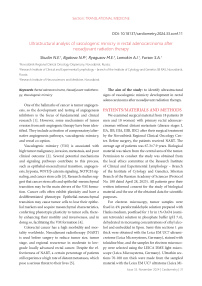Ultrastructural analysis of vasculogenic mimicry in rectal adenocarcinoma after neoadjuvant radiation therapy
Автор: Skudin N.E., Bgatova N.P., Ryaguzov M.E., Lomakin A.I., Fursov S.A.
Журнал: Cardiometry @cardiometry
Статья в выпуске: 33, 2024 года.
Бесплатный доступ
One of the hallmarks of cancer is tumor angiogenesis, so the development and testing of angiogenesis inhibitors is the focus of fundamental and clinical research. However, some mechanisms of tumor evasion from anti-angiogenic therapy have been identified. They include activation of compensatory/alternative angiogenesis pathways, vasculogenic mimicry, and vessel co-option.
Rectal adenocarcinoma, neoadjuvant radiotherapy, vasculogenic mimicry
Короткий адрес: https://sciup.org/148329777
IDR: 148329777 | DOI: 10.18137/cardiometry.2024.33.conf.11
Текст статьи Ultrastructural analysis of vasculogenic mimicry in rectal adenocarcinoma after neoadjuvant radiation therapy
Colorectal cancer has a high morbidity and mortality worldwide. Neoadjuvant radiotherapy (NART) is used before surgery to reduce tumor size, tumor stage, and regional recurrence in moderate to low-grade locally advanced rectal cancer. Despite the effectiveness of NART, a certain percentage of patients still experience a high rate of distant metastases, which pose a serious threat to their lives [5].
The aim of the study: to identify ultrastructural signs of vasculogenic mimicry development in rectal adenocarcinoma after neoadjuvant radiation therapy.
PATIENTS/MATERIALS AND METHODS
We examined surgical material from 18 patients (8 men and 10 women) with primary rectal adenocarcinomas without distant metastasis (disease stages I, IIA, IIB, IIIA, IIIB, IIIC) after their surgical treatment by the Novosibirsk Regional Clinical Oncology Center. Before surgery, the patients received NART. The average age of patients was 67.3±7.9 years. Biological material was taken from the central area of the tumor. Permission to conduct the study was obtained from the local ethics committee at the Research Institute of Clinical and Experimental Lymphology – Branch of the Institute of Cytology and Genetics, Siberian Branch of the Russian Academy of Sciences (Protocol No. 180 dated April 28, 2023). All patients gave their written informed consent for the study of biological material and the use of the obtained data for scientific purposes.
For electron microscopy, tumor samples were fixed in 4% paraformaldehyde solution prepared with Hanks medium, postfixed for 1 hr in 1% OsO4 (osmium tetroxide) solution in phosphate buffer (pH 7.4), dehydrated in increasing concentrations of ethyl alcohol and embedded in Epon. Semi-thin sections 1 μm thick were obtained with the Leica EM UC7 ultramicrotome (Leica Microsystems, Germany), stained with toluidine blue, and the samples for electron microscopy were selected using the LEICA DME light microscope (Leica Microsystems, Germany). Ultrathin sections 70-100 nm thick were made from the sampled material with the Leica EM UC7 ultratome (Leica Mi- crosystems, Germany) and contrasted with a saturated aqueous solution of uranyl acetate and lead citrate. Photographs of tumor vessels were obtained using the JEM 1400 electron microscope (JEOL, Japan) at the Center for Collective Use of Microscopic Analysis of Biological Objects at the Siberian Branch of the Russian Academy of Sciences with an electron microscope magnification of 3000x, 6000x, and 30,000x.
RESULTS
The ultrastructural analysis of the vascular bed of rectal adenocarcinoma has revealed that the vessel wall is often lined with cells of different structures. Among them there were typical endothelial cells with electron-dense cytoplasm and large cells, bulging into the lumen of the vessel, with a small number of organelles, mainly free polysomal ribosomes, with the absence of pinocytotic vesicles. Endothelium-like cells were identified, which had an elongated shape, where some individual vesicular structures were present; revealed were polysomes and membranes of the granular endoplasmic reticulum. Those cells were connected to neighboring cells by means of desmosome-type contacts. There were some vessels, in the walls of which tumor cells with a high number of organelles were determined. In such vessels, endothelial cells had a typical structure and interdigitating-type contacts. Among the contacts of endothelial and endothelium-like cells, loose end-to-end contacts prevailed.
CONCLUSION
Our ultrastructural analysis of rectal adenocarcinoma has revealed cells of different structures that form the wall of the microcirculatory bed vessels. Along with typical narrow endothelial cells with vesicular structures in the cytoplasm and the presence of tight contacts of the interdigitating type, large cells with the absence of exchange vesicles and the predominance of free polysomal ribosome complexes were observed. In addition, there were elongated endothelium-like cells with single vesicular structures, the presence of free polysomes and a small content of granular endoplasmic reticulum membranes in the cytoplasm. The contacts between endothelial and endothelial-like cells had a loose end-to-end appearance. The observed differences in the cells lining the adenocarcinoma vessels may be due to the development of vasculogenic mimicry that requires further studies.
Список литературы Ultrastructural analysis of vasculogenic mimicry in rectal adenocarcinoma after neoadjuvant radiation therapy
- Pandiar D, Smitha T, Krishnan RP. Vasculogenic mimicry. J Oral Maxillofac Pathol. 2023;27(1):228-9. DOI: 10.4103/jomfp.jomfp_532_22
- Wei X, Chen Y, Jiang X, et al. Mechanisms of vasculogenic mimicry in hypoxic tumor microenvironments. Mol Cancer;20(1):7. DOI: 10.1186/s12943-020-01288-1
- Luo Q, Wang J, Zhao W, et al. Vasculogenic mimicry in carcinogenesis and clinical applications. J Hematol Oncol. 2020;13(1):19. DOI: 10.1186/s13045-020-00858-6
- Tang H, Chen L, Liu X, et al. Pan-cancer dissection of vasculogenic mimicry characteristic to provide potential therapeutic targets. Front Pharmacol. 2024;15:1346719. DOI: 10.3389/fphar.2024.1346719
- Nahas SC, Rizkallah Nahas CS, Sparapan Marques CF, et al. Pathologic Complete Response in Rectal Cancer: Can We Detect It? Lessons Learned From a Proposed Randomized Trial of Watch-and-Wait Treatment of Rectal Cancer. Dis Colon Rectum. 2016;59(4):255- 63. DOI: 10.1097/DCR.0000000000000558


